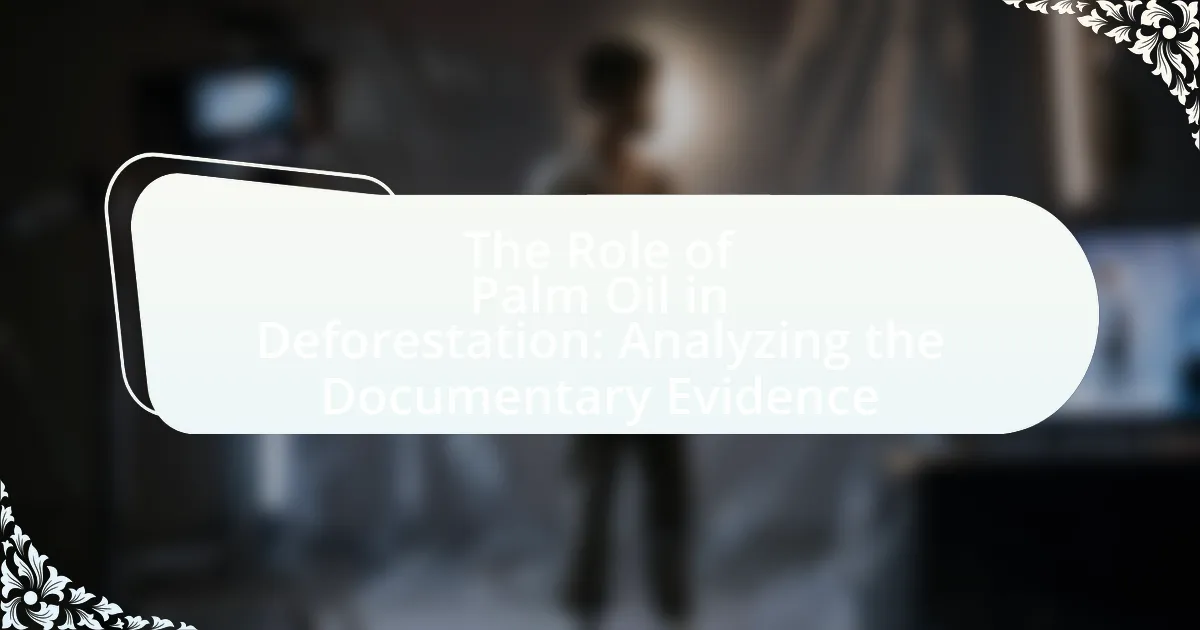The article examines the significant relationship between palm oil production and deforestation, highlighting its role as a leading cause of forest loss, particularly in tropical regions like Indonesia and Malaysia. It details how the expansion of palm oil plantations contributes to habitat destruction, biodiversity decline, and increased greenhouse gas emissions, with approximately 27% of global deforestation attributed to this industry. The article also explores the economic benefits of palm oil cultivation, the social implications for local communities, and the urgent need for sustainable practices to mitigate environmental degradation. Additionally, it reviews documentary evidence that illustrates the impact of palm oil on deforestation and the methodologies used to analyze these effects.

What is the relationship between palm oil and deforestation?
The relationship between palm oil and deforestation is direct and significant, as the expansion of palm oil plantations is a leading cause of forest loss, particularly in tropical regions. According to the World Wildlife Fund, approximately 27% of global deforestation between 2000 and 2018 was attributed to palm oil production. This agricultural practice often involves clearing vast areas of rainforest, which not only destroys biodiversity but also contributes to greenhouse gas emissions. In Indonesia and Malaysia, the two largest producers of palm oil, millions of hectares of forest have been converted into plantations, resulting in habitat destruction for endangered species and disruption of local ecosystems.
How does palm oil production contribute to deforestation?
Palm oil production contributes to deforestation primarily through the conversion of forests into palm oil plantations. This process involves clearing large areas of tropical rainforest, which leads to habitat loss for numerous species and significant carbon emissions. According to the World Wildlife Fund, approximately 90% of palm oil is produced in Indonesia and Malaysia, where extensive deforestation has occurred; between 1990 and 2010, Indonesia lost around 6 million hectares of forest due to palm oil expansion. This deforestation not only threatens biodiversity but also disrupts local communities and contributes to climate change by releasing stored carbon dioxide into the atmosphere.
What are the primary drivers of deforestation linked to palm oil?
The primary drivers of deforestation linked to palm oil are agricultural expansion, particularly for palm oil plantations, and infrastructure development. Agricultural expansion accounts for approximately 80% of deforestation in tropical regions, with palm oil being a significant contributor due to its high demand and profitability. Infrastructure development, including roads and urbanization, facilitates access to previously untouched forests, further accelerating deforestation rates. According to the World Wildlife Fund, palm oil production has led to the loss of over 3 million hectares of rainforest in Indonesia alone from 1990 to 2010, highlighting the severe impact of these drivers on forest ecosystems.
How does land conversion for palm oil affect biodiversity?
Land conversion for palm oil significantly reduces biodiversity by destroying natural habitats. This process leads to the loss of various species, as ecosystems are disrupted and fragmented. For instance, the conversion of tropical forests into palm oil plantations has been linked to a decline in species such as orangutans and tigers, which rely on these forests for survival. According to a study published in the journal “Biodiversity and Conservation,” approximately 50% of the original biodiversity in Southeast Asia has been lost due to palm oil expansion. This loss not only affects individual species but also undermines ecosystem services that are vital for environmental health and human well-being.
Why is palm oil a significant agricultural commodity?
Palm oil is a significant agricultural commodity due to its high yield and versatility in various industries. It is the most widely produced vegetable oil globally, with an average yield of 3.7 tons per hectare, which is substantially higher than that of other oil crops like soybean and sunflower. This high productivity makes palm oil a cost-effective option for food products, cosmetics, and biofuels. Additionally, palm oil accounts for approximately 35% of the global vegetable oil market, highlighting its economic importance. The demand for palm oil continues to rise, driven by its use in processed foods and personal care products, further solidifying its status as a key agricultural commodity.
What are the economic benefits of palm oil cultivation?
Palm oil cultivation provides significant economic benefits, including job creation, increased agricultural productivity, and substantial export revenues. The industry supports millions of jobs globally, with approximately 4.5 million people employed in palm oil production in Indonesia and Malaysia alone. Additionally, palm oil is one of the most efficient oil crops, yielding up to 10 times more oil per hectare compared to other vegetable oils, which enhances agricultural productivity. Furthermore, palm oil exports contribute significantly to the economies of producing countries; for instance, in 2020, palm oil exports accounted for about 10% of Indonesia’s total export revenue, highlighting its importance in generating foreign exchange and supporting local economies.
How does global demand for palm oil influence deforestation rates?
Global demand for palm oil significantly drives deforestation rates, as the expansion of palm oil plantations often leads to the clearing of forests. In Indonesia and Malaysia, which produce over 85% of the world’s palm oil, approximately 3 million hectares of forest are lost annually due to agricultural conversion, primarily for palm oil cultivation. This conversion not only reduces biodiversity but also contributes to greenhouse gas emissions, as carbon stored in trees is released into the atmosphere. Studies indicate that the rapid increase in palm oil demand, particularly from countries like China and India, correlates with heightened deforestation, as land is cleared to meet the growing market needs.

What documentary evidence exists regarding palm oil and deforestation?
Documentary evidence regarding palm oil and deforestation includes satellite imagery, scientific studies, and reports from environmental organizations. Satellite imagery has shown significant forest loss in Southeast Asia, particularly in Indonesia and Malaysia, where palm oil plantations have expanded. A study published in the journal “Nature” in 2018 indicated that palm oil cultivation was responsible for approximately 10% of global deforestation between 2000 and 2018. Additionally, reports from organizations like the World Wildlife Fund and Greenpeace document the direct correlation between palm oil production and habitat destruction, highlighting the impact on biodiversity and carbon emissions. These sources collectively provide a robust framework of evidence linking palm oil to deforestation.
What key documentaries address the impact of palm oil on forests?
Key documentaries that address the impact of palm oil on forests include “Before the Flood,” which highlights the environmental consequences of palm oil production, and “The True Cost,” which examines the broader implications of consumerism, including palm oil’s role in deforestation. “Our Planet” also features segments on palm oil’s impact on biodiversity and forest ecosystems. These documentaries provide visual evidence and expert commentary on how palm oil cultivation contributes to habitat destruction and climate change, reinforcing the urgent need for sustainable practices.
What findings do these documentaries present about deforestation rates?
The documentaries present findings that deforestation rates are significantly driven by palm oil production, with estimates indicating that approximately 80% of deforestation in Southeast Asia is linked to this industry. Specific evidence from the documentaries highlights that between 1990 and 2010, Indonesia lost around 6 million hectares of forest annually, largely due to palm oil plantations. Furthermore, the documentaries emphasize the alarming rate at which biodiversity is being lost, with the World Wildlife Fund reporting that palm oil expansion threatens the habitats of endangered species such as orangutans and tigers.
How do these documentaries portray the social implications of palm oil production?
Documentaries portray the social implications of palm oil production by highlighting issues such as land displacement, labor exploitation, and the impact on indigenous communities. For instance, they often depict how large-scale palm oil plantations lead to the eviction of local populations, disrupting their livelihoods and cultural practices. Additionally, these films frequently showcase the harsh working conditions faced by laborers, including low wages and inadequate safety measures, which reflect broader systemic inequalities in the industry. Specific examples include the documentary “Before the Flood,” which illustrates the struggles of communities in Indonesia affected by palm oil expansion, emphasizing the urgent need for sustainable practices and ethical sourcing.
What methodologies are used in documentaries to analyze deforestation?
Documentaries analyzing deforestation typically employ methodologies such as qualitative interviews, observational research, and data visualization. Qualitative interviews with local communities, environmental experts, and policymakers provide personal insights and contextual understanding of deforestation’s impacts. Observational research involves on-the-ground footage and aerial surveys to visually document deforestation patterns and their consequences. Data visualization techniques, including graphs and infographics, help convey complex information about deforestation rates and palm oil’s role in this process, making the data accessible and engaging for viewers. These methodologies collectively enhance the documentary’s narrative and provide a comprehensive analysis of deforestation issues.
How do filmmakers gather evidence on palm oil’s impact on deforestation?
Filmmakers gather evidence on palm oil’s impact on deforestation primarily through field research, interviews with experts, and analysis of satellite imagery. Field research allows filmmakers to document firsthand the environmental changes in areas affected by palm oil plantations, providing visual evidence of deforestation. Interviews with environmental scientists, local communities, and activists offer insights into the socio-economic and ecological consequences of palm oil production. Additionally, filmmakers utilize satellite imagery to track deforestation rates over time, revealing the extent of land conversion for palm oil cultivation. This combination of methods ensures a comprehensive understanding of the issue, supported by concrete visual and testimonial evidence.
What role do interviews and expert opinions play in these documentaries?
Interviews and expert opinions serve as critical components in documentaries about palm oil and deforestation, providing credibility and depth to the narrative. These elements allow filmmakers to present informed perspectives from scientists, environmentalists, and industry experts, which enhances the audience’s understanding of complex issues surrounding palm oil production and its environmental impact. For instance, expert testimonies can reveal the ecological consequences of deforestation, supported by data on biodiversity loss and carbon emissions, thereby reinforcing the documentary’s message with factual evidence.

What are the implications of palm oil-related deforestation?
Palm oil-related deforestation leads to significant environmental and social implications. The destruction of tropical forests for palm oil plantations results in habitat loss for endangered species, such as orangutans and tigers, contributing to biodiversity decline. Additionally, deforestation releases substantial amounts of carbon dioxide into the atmosphere, exacerbating climate change; for instance, the World Resources Institute estimates that land-use change, including palm oil cultivation, accounts for approximately 10% of global greenhouse gas emissions. Furthermore, local communities often face displacement and loss of livelihoods as their land is converted for palm oil production, leading to social conflicts and economic instability. These implications highlight the urgent need for sustainable practices in palm oil production to mitigate environmental degradation and protect vulnerable populations.
How does deforestation for palm oil affect local communities?
Deforestation for palm oil negatively impacts local communities by displacing populations, reducing access to traditional lands, and diminishing resources such as food and clean water. As palm oil plantations expand, indigenous and rural communities often lose their homes and livelihoods, leading to increased poverty and social conflict. A study by the World Resources Institute indicates that over 1.5 million people have been affected by land conversion for palm oil in Indonesia alone, highlighting the scale of displacement and resource loss. Additionally, the destruction of forests disrupts local ecosystems, further threatening the food security and health of these communities.
What are the health and economic impacts on indigenous populations?
Indigenous populations experience significant health and economic impacts due to deforestation linked to palm oil production. Health-wise, these communities often face increased rates of respiratory diseases, malnutrition, and mental health issues stemming from environmental degradation and loss of traditional livelihoods. For instance, studies indicate that air quality deterioration from forest fires associated with land clearing for palm oil contributes to respiratory ailments among indigenous peoples. Economically, deforestation disrupts traditional practices and access to resources, leading to loss of income and food security. Research shows that indigenous communities reliant on forest resources for their livelihoods suffer economically when palm oil plantations replace their ancestral lands, resulting in diminished economic opportunities and increased poverty levels.
How does deforestation disrupt local ecosystems and livelihoods?
Deforestation disrupts local ecosystems and livelihoods by eliminating habitats, reducing biodiversity, and altering water cycles. The removal of trees leads to habitat loss for countless species, which can result in population declines or extinctions, as evidenced by studies showing that deforestation in the Amazon has led to a 30% decrease in species richness. Additionally, the disruption of water cycles can cause changes in rainfall patterns, affecting agriculture and water availability for local communities. For instance, regions that have experienced significant deforestation often face increased flooding and drought, directly impacting the livelihoods of farmers and indigenous populations who rely on stable environmental conditions for their subsistence.
What actions can be taken to mitigate the impact of palm oil on deforestation?
To mitigate the impact of palm oil on deforestation, implementing sustainable palm oil certification schemes is essential. These schemes, such as the Roundtable on Sustainable Palm Oil (RSPO), establish criteria for environmentally responsible production, which helps reduce deforestation rates. For instance, RSPO-certified plantations must adhere to strict guidelines that protect high conservation value areas and promote reforestation efforts. Additionally, promoting the use of alternative oils, such as sunflower or soybean oil, can decrease reliance on palm oil, further alleviating pressure on forests. Research indicates that sustainable practices can significantly lower deforestation rates associated with palm oil production, demonstrating the effectiveness of these actions.
What are the best practices for sustainable palm oil production?
The best practices for sustainable palm oil production include adhering to certification standards such as the Roundtable on Sustainable Palm Oil (RSPO), implementing agroforestry techniques, and ensuring traceability throughout the supply chain. Certification by RSPO requires compliance with environmental and social criteria, which helps mitigate deforestation and promotes biodiversity. Agroforestry techniques, which integrate palm oil cultivation with other crops, enhance ecosystem health and reduce reliance on monoculture practices. Traceability ensures that palm oil is sourced from sustainable plantations, preventing illegal deforestation and promoting responsible land use. These practices collectively contribute to reducing the negative environmental impacts associated with palm oil production.
How can consumers influence palm oil production practices?
Consumers can influence palm oil production practices by demanding sustainably sourced palm oil and supporting brands that adhere to responsible sourcing standards. This consumer behavior drives companies to adopt more sustainable practices, as evidenced by the rise of the Roundtable on Sustainable Palm Oil (RSPO), which certifies sustainable palm oil production. Research indicates that consumer preferences for certified products can lead to significant changes in industry practices, as companies respond to market demands to maintain their customer base and brand reputation.
What resources are available for further understanding palm oil and deforestation?
Resources for further understanding palm oil and deforestation include academic journals, reports from environmental organizations, and documentaries. Notable academic journals such as “Environmental Research Letters” and “Global Environmental Change” publish peer-reviewed studies on the impact of palm oil cultivation on deforestation. Reports from organizations like the World Wildlife Fund (WWF) and Greenpeace provide comprehensive analyses and data on palm oil’s role in deforestation, highlighting statistics such as the loss of over 10 million hectares of rainforest due to palm oil expansion from 1990 to 2015. Documentaries like “Before the Flood” and “The True Cost of Palm Oil” visually depict the environmental consequences of palm oil production, making the information accessible to a broader audience. These resources collectively offer a well-rounded understanding of the complex relationship between palm oil and deforestation.

Leave a Reply